
I had to curtail my usual Tuesday rundowns of old-ass Genesis games this week due to being tied up (in a good way, but not in that kind of good way) by all the Giant Bomb Extra Life charity streaming last weekend. (Speaking of which, thanks to all those who got involved, either with your own streams or supporting others as donors and/or as an audience.) Instead, I've decided to write about a game that has almost completely absorbed my November thus far and may well continue to do so for a few more weeks at least: Team Ninja and Koei Tecmo's Nioh 2.
For those unfamiliar, Koei (back when it was still on its own) originally found its fame and fortune through a strategy simulation series named Nobunaga no Yabou, or Nobunaga's Ambition, which was set during the Japanese Sengoku era (1467-1615 by our calendar). While he was the nominal protagonist of the series, Nobunaga Oda was simply one of many playable daimyo, or feudal lords, vying for control of the Nihon archipelago. The Nioh games revisit the same conflict from the perspective of an agent with some connection to the Japanese otherworld of the yokai, which is invariably related to the human machinations behind the Sengoku conflict. Nioh 2 specifically has the protagonist be the unnamed product of the uncommon pairing of a human and a yokai, who finds him or herself involved with the years-long rise of the scrappy but shrewd rogue Tokichiro as he eventually becomes a certain major historical figure, all the while surreptitiously pursuing the mysterious villain behind his/her yokai mother's murder.
The Nioh games are quite flagrantly built upon the action-RPG blueprint established by FromSoftware's Souls franchise, though taken in some more oblique directions - as if the original series wasn't obtuse enough - to both better fit the themes of yokai powers and the warfare typical of feudal Japan, and to distinguish itself from Souls and its other imitators. The first Nioh, released 2017, burst out of the Torii gate with a host of new ideas and features as well as an entirely new format for the burgeoning "Soulslike" sub-genre, and it's assumed Nioh 2 expects a certain amount of familiarity from its players (though, it should be said, has an entirely unrelated plot) in that it took Nioh's template and added several extra layers of complexity and character development largely related to the protagonist's half-yokai heritage. The best comparison I could think to make is that Nioh is the Castlevania: Symphony of the Night to Nioh 2's Castlevania: Aria of Sorrow: by establishing a protagonist with a much stronger connection to the netherworld forces, and introducing mechanics that have them relying on the very powers they're fighting against, you create a more compelling diagram for character advancement and, arguably, a more intriguing personal story to boot.
For the sake of keeping things somewhat focused here, I want to talk about Nioh 2's many systems in brief to give you some idea of the complexity involved. As stated above, Nioh 2 takes all of Nioh's extant systems - its many weapon types with their own individual skill trees, the stance system, yokai mechanics, player revenants, ninja and onmyo jutsu, the many services available at the blacksmith, etc. - and layers on top several more regarding the player's unique connection to the yokai (to wit: acquiring and attuning Soul Cores, traversing the Dark Realm, and the Yokai Shift ability). I'll try to balance brevity with adequate expatiation as I go through this list of features, since my intent here is to demonstrate the broad learning curve and mechanical depth of the Nioh series without necessarily suggesting that it's all too much to internalize; after all, I'm managing it so far, and I'm an idiot. Demonstrably so!
(TL;DR: I'm about to get very geeky about Nioh's mechanics, in particular those that aren't shared with games of a similar format.)
1. The Mission Format
Arguably the biggest departure from the Souls franchise, which I'll be referring to a lot despite that being the number one video game critique faux pas, is that Nioh uses a mission-based structure where each of its "stages" exists in a bubble irrespective of the others. This runs counter to every other Soulslike, of course, which take place in one large contiguous world map barring the occasional "Painted World of Ariamis" situation where you're temporarily whisked off to a self-contained area. Nioh is further split into "main mission" stages, which are fairly large, and "side mission" stages which are either smaller unique areas or are greatly diminished versions of the main mission stages (usually with many previous areas now gated off and inaccessible). Once you've completed the main objective of the stage, usually a boss fight, you're free to exit back to the hub. The hub area is entirely menu-driven and includes a shrine, which also exist as checkpoints in stages and allow you to level up and change loadouts, as well as vendors, an index of yokai, major characters, and story synopses you can refer back to, a dojo for training and tutorials, and the mission-select map screen.
The mission-based structure gives Nioh a very different feeling of progression to the Souls series, for better and worse. Instead of making gradual progress across an immense world, discovering shortcuts back to earlier areas and working your way through alternative paths, a single Nioh 2 stage is a mostly linear affair (though handy backtracking shortcuts are still plentiful) that you never need to revisit unless you missed something important or end up in a different version of it in one of the side-missions. Where it becomes both a strength and a weakness is in how the game is built in such an episodic way that it's easier to place it aside for a longer hiatus; with Souls, you're always developing a mental map of your current understanding of the world, and trying to keep in mind half a dozen alternative paths you've abandoned either because you lacked a key item or because the enemies were too strong. The Souls games are thus harder to put down for extended periods, because so much of your continued progress relies on that kind of transitory information. In Nioh, however, each map is different or - in the case of side-mission revisits - have a completely different assortment of item and enemy placements that makes any prior geographical knowledge redundant.
We'll be making it clear as this list continues that you probably don't want to leave Nioh alone too long or else allow your familiarity with its mechanics to atrophy, which might spell disaster as the game's challenge level continues to rise, but it is overall more conducive towards choosing to play the game sporadically.
2. The Stances
Honestly, stances don't play as large a part in the combat as intimidated outsiders seem to believe, or at the very least they're not as hard to wrap one's mind around. There's something almost bewitching about the concern of being in "the wrong stance", or that your combat potential is diminished by eschewing the stance aspect completely for the sake of always being in the "neutral" mid-stance. I will say the latter works just fine if you really don't feel like screwing around with stances, but I think this system is better understood if you came to Nioh via Bloodborne (given Nioh 2 is still a PS4 exclusive as of writing, an audience overlap is probably more likely than not). In Bloodborne you have two "stances" based on the trick weapon system: any given weapon can be in a smaller, faster form or a larger, slower form, and there are mechanics for switching on the fly even in the middle of combos. The stances work the same way here: the high stance is slower but does more damage and usually has more reach (a lot of this is conditional to the weapon type you're using, incidentally), while low stance is usually the exact opposite. Low and high stance can also apply to where your opponent is situated: low stance is great for smaller enemies or those closer to the ground, like the "dweller" zombies that drop to all-fours, while high stance can involve a lot of overhead attacks that can catch flying enemies or those which have weak spots high above you (say, the gigantic One-Eyed Oni cyclopses).
(As if to help onboard the Bloodborne crowd, one of the new weapon types introduced to Nioh 2 is the Switchglaive: a weapon that should prove familiar to Bloodborne players in that it changes between three forms (via the three stances) of saw (low), saw-spear (mid), and scythe (high).)
Where stances arguably become more complex and more specific is in how each weapon skill tree has separate branches for skills that only apply to low, mid, or high stance. This changes the behavior of those stances in turn, as some become more effective for counter-attacks and others for evasion or blocking. High stance usually has some charge moves, which do even more damage in exchange for a period of build-up. And, again, this is all highly conditional to the weapon type you're using. Given that you're probably going to stick to just one or two weapon types - each one relies on a different stat to boost its damage output via weapon scaling, and there's little to be gained by raising all stats evenly - it's worth experimenting with all of them at first to see which ones you want to stick with. I mean, obviously I went with the aforementioned Bloodborne weapon, but there's a decent mix of common and exotic types to try, the latter including the tonfa and the hard-to-use-but-fun-to-master kusarigama.

3. Yokai and the Dark Realm
The above two are the big differences between Nioh and its competitors, and the expanded yokai mechanics are the big difference between Nioh and Nioh 2. All the enemies in this game can be roughly categorized into two groups: human and yokai. Human opponents fight like you'd expect them to, allowing for the fact that they have different weapons which have distinct attack animations, but the yokai are much more varied in their designs and their combat approaches. One major distinction between the two groups is that yokai cannot regenerate Ki (the game's equivalent of stamina) naturally, but can do so by creating "yokai realms" - circular AoEs of negative energy that recharges them and drops Ki restoration speed for humans - that the player can extinguish with a "Ki burst" (right-trigger the moment after swinging a weapon; it also boosts your Ki restoration rate if you get it perfect).
New to Nioh 2 are Dark Realm zones: areas where the "yokai realm" effect is active everywhere. Dark Realms can only be extinguished by defeating the yokai generating it; usually the largest and toughest one roaming around the area. Fortunately, as a half-yokai, the protagonist isn't entirely powerless, as they can fall back on their yokai nature to survive. These gifts include the Yokai Shift - this works like Devil May Cry's Devil Trigger or Yakuza's Ultimate Heat Mode, in that the protagonist is temporarily indestructible and has access to much stronger attacks but only for a limited duration - and Yokai Abilities, which has the protagonist summon a yokai for a single attack. The stat that governs this, anima, is typically restored after defeating yokai and acquiring their "Soul Cores" - which is also how you summon them - so you can rely on these skills a lot in yokai areas and especially in Dark Realm zones where it regenerates even faster. (I generally hold back on Yokai Shifts until the boss, however.)
It's certainly a lot to take in, more so if you're new to Nioh and have everything else on this list to consider, and it took several hours before I'd grown used to having these yokai powers at hand and could integrate them into my tactics along with items, jutsu (magic), and the stances and light/heavy attacks. Having them around has certainly made life easier though.
One last note about yokai: there are some fun ones that respond to gestures (emotes) and items, and it's worth finding out which ones those are. Make them happy, and they'll drop all their loot and leave without a fight.
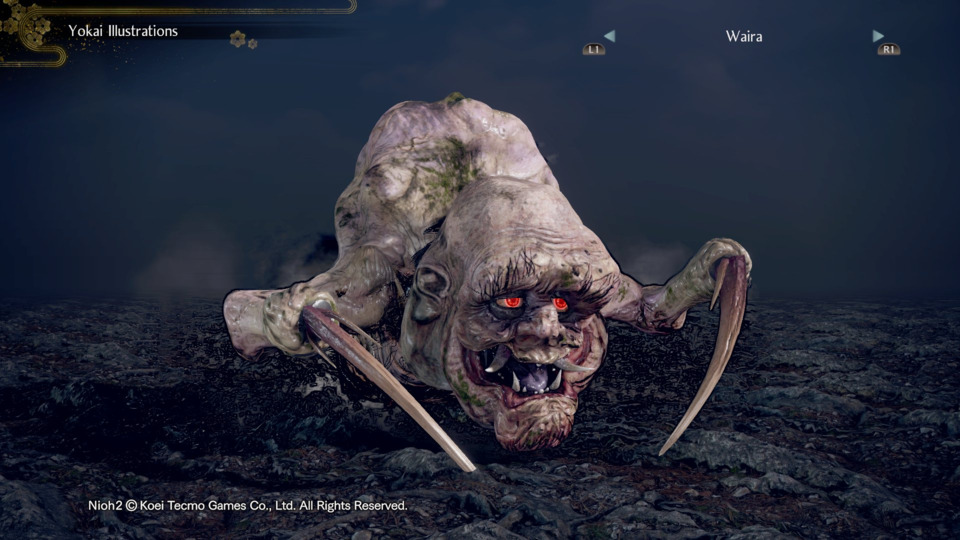
4. Soul Cores and Guardian Spirits
I mentioned Soul Cores above, and they're one of the many ways you can customize your protagonist. It starts with the Guardian Spirits: spectral protectors, usually shaped like animals, that accompany most of the game's major NPCs and will eventually follow you also (via "spirit division"). Each of these Guardians can equip two Soul Cores, which are sometimes left behind by dead yokai, and provide you with two yokai summon abilities in addition to a bunch of passive boosts not unlike those found on equipment. You can even fuse multiple Soul Cores of the same kind together to increase their effect. This is where the Aria of Sorrow comparison is most keenly applicable: by equipping the right souls to your particular playstyle, you can really get some mileage out of their Yokai Abilities and their passive boosts alike.
Something I've not tinkered around with much yet is how each Guardian Spirit has a class: Feral, Brute, and Phantom, which roughly correspond to three builds your character might have: the fast attacker with minimal armor that relies on dodging more than blocking; the heavy tank that is the exact opposite; and the bow/magic-user that prefers to keep their distance if at all possible. I've been sticking with Feral because that's been my style with Bloodborne and the previous Nioh, but Phantom seems compatible to what I've got going on here build-wise too so I might try one of those out.
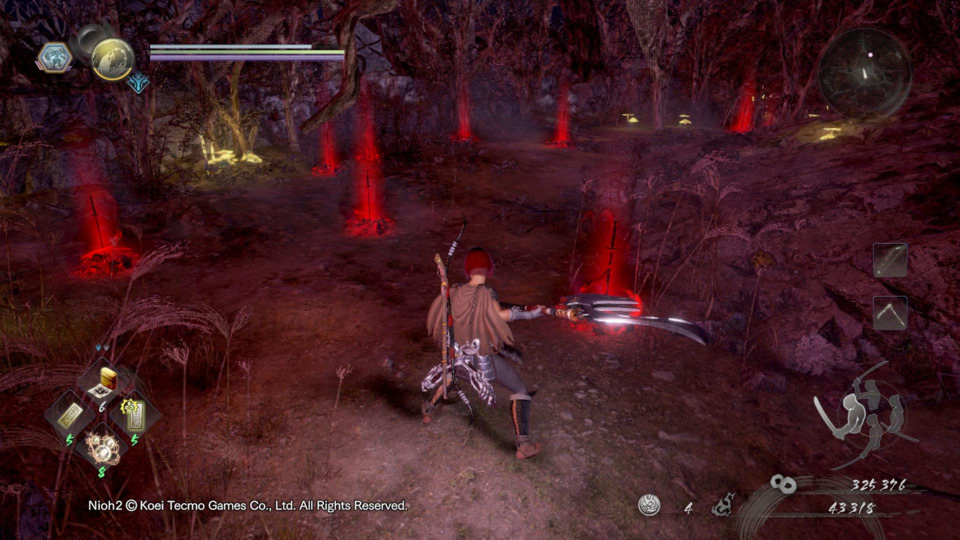
5. Jutsu
I completely overlooked Jutsu in Nioh 1 right up until the end of the game, whereupon I decided to go for all the weapon/jutsu specific trophies. Jutsu works like priest and mage magic in the Souls games, in that you have a finite pool of "spell picks" (Vancian magic strikes again!) that you prepare beforehand at shrines (the bonfire equivalent). Instead of holy and arcane magic, though, you have ninja and onmyo jutsu: ninja jutsu tends to involve a lot of projectiles, stealth, and poison/debuffs, while onmyo jutsu is mostly putting elemental damage on weapons or resistances on armor, though with a few magical projectiles too. However, both the ninja and onmyo skill trees are far more elaborate and offer many more customization options for players to use once you get deeper into them, and by increasing the power and capacity of your chosen jutsu type the player can use many jutsu skills simultaneously. It's perhaps better suited for multiplayer given the sheer volume of jutsu types can make practitioners dangerously unpredictable, but having that boon in the PvE single-player is still handy.
Since the Switchglaive uses the magic stat for damage scaling, which also determines the strength of onmyo magic, that's where my non-weapon character development has been focused. The various yokai types respond differently to each element, but I've been getting a lot of mileage out of lightning in particular. I'm now wielding lightning ranged magic and a lightning buff, with both water and "purify" (which has a flat bonus against all yokai types but does nothing against humans) as back-ups in case I'm fighting something lightning-resistant. Should be worth pointing out that, like Souls magic, the jutsu aren't something you can rely on as your sole damage output given how few of them you can have at any time. They exist more to complement your normal melee style, and best applied when you have a bit of distance or a moment of enemy recovery time to toss something out, like the rest of the consumables. Endlessly renewable consumables is the best way of framing them, I suppose.
The wildest thing I've found related to jutsu is that, because you need more item shortcuts to really make use of a full repertoire, you can actually add more item shortcut wheels by simply going deep into the game options menu and turning them on. I guess the game defaults to two (out of a possible four) to keep the shortcut function from being too cluttered? Suffice it to say, if you've ever played a Souls game, having four of those shortcut menus - each of which has four slots to correspond with the four D-pad directions - gives you quite a lot to work with. Provided you remember where you assigned your healing elixirs...
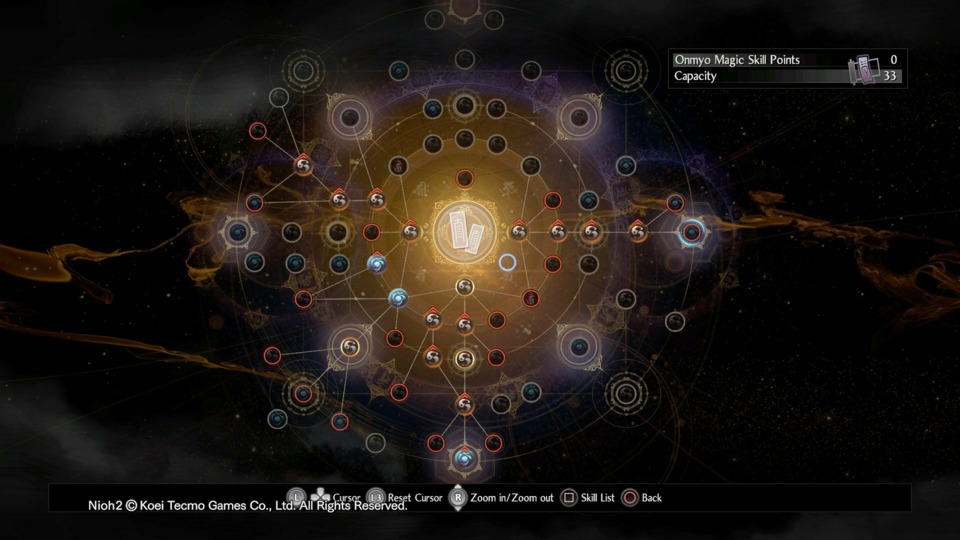
6. Blacksmithery
This is already running long and I feel like I could be here all day with the blacksmith facilities, but it's worth emphasizing just how fully it takes advantage of the game's loot system (which follows the same rarity rules as a lot of loot RPGs, including how item rarity determines how many passive boosts a piece of equipment can hold at once). In short, then:
- Buy/Sell: Self-explanatory. Selling might not always be the best option for your vendor trash though.
- Forging: The reason you'd go to a blacksmith. By disassembling vendor trash into their core materials, you can use those materials to craft a randomly determined piece of equipment close to your current level, based on a specific "model" of a weapon or armor type (say, if you wanted a full suit of ninja clothes). Materials have rarity ratings also, and higher rarity materials mean a greater chance of the forged piece also being rare.
- Soul Match: If you really have money to burn, you can soul match your current weapon to a second one of a higher level, transferring that level over at the cost of using up said secondary weapon. There's a few reasons you'd want to do this, but it can get prohibitively expensive if the item is rare.
- Refashion: Despite "Fashion Souls" being a huge concern to many, very few Souls games actually let you change the look of your equipment thereby allowing you to turn your presently equipped mishmash of different armor sets into one cohesive style. Refashioning is a cheap way of making any piece of gear look like any other piece of gear, provided you've encountered it before. It also means you won't have to resort to holding onto a piece of crappy armor because you prefer how it looks on you.
- Temper: One of my favorite buried menu options is tempering equipment, which essentially lets you burn one moderately rare material to change any piece of equipment's passive boost into a different one. If you're good for fire resistance or simply don't care about it, for instance, you can transform it into something else entirely - maybe a boost to HP or extra weapon damage. The material in question, umbracite, can easily be farmed from disassembling moderately rare vendor trash.
- Remodel: This remains locked for most of the game, and is incredibly expensive to do, but will allow you to change the damage scaling of a weapon. That is, if your current weapon primarily uses the strength stat to determine damage, you can switch it to, say, skill or constitution instead. This is an excellent way to start branching out into other weapon types that maybe never had the scaling you wanted, and seems best suited for the end-, post-game, or NG+ runs.
- Disassemble: Self-explanatory, and probably a better value proposition for rare vendor trash. The cheaper stuff you might as well hock, or give away to the Kodama (Kodama love free shit).
It's no overstatement to say that's much more you can do with your garbage beyond simply selling it, and I didn't even get into passive boosts that can be inherited or equipment set bonuses. Nioh 2 is, as it is with most everything else, pretty intense about its equipment micromanagement.
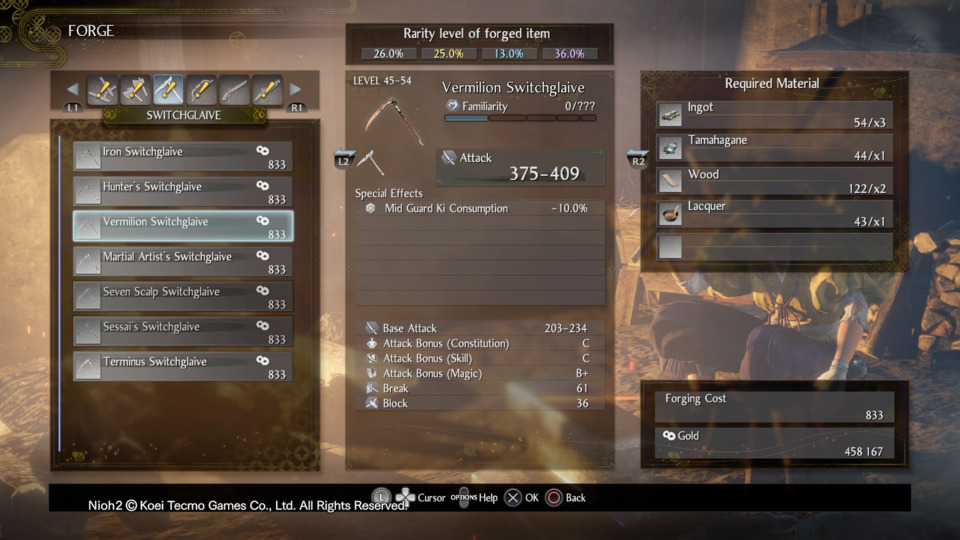
7. Agyo and Ungyo
One last tidbit to send us off is the Agyo and Ungyo (two halves of the Buddhist concept of Nioh, or twin deva guardian statues, after which the game is named) system, which carries over from the first Nioh. These are simply two lists of in-game achievements that reward you with reputation once earned, and tend to involve killing a certain number of foes with a specific weapon, or with a specific element, or of a specific enemy type. The big earners tend to be challenges like defeating a boss without getting hit, or completing stages without dying or using the shrines to recover, or killing enemies with your bare hands, many of which become a lot easier if you return to the early game at a much higher experience level.
The benefit of earning reputation is that they unlock permanent passive boosts to that character's profile. It's not unlike the achievement system used by the later Borderlands games, but very easy to miss all the same. I think I had about twenty bonuses stacked up the first moment I remembered it existed.
Anyway, I've exhausted almost every topic relevant to my Nioh 2 playthrough (I didn't even touch the online features beyond player revenants, since most require PS+) but I'm not dismissing the possibility that there's even more features out there that I've either somehow ignored or haven't been unlocked yet. Nioh 2 is a very dense game, not just mechanically but also narratively as its story flits through several decades of history, but I think if you take the time to learn its nuances it can be something very rewarding. It occurs to me that something similar could be said for the Musou games that Koei Tecmo also makes, via its Omega Force subsidiary, but I'd prefer not to think too hard about that. I'd rather deal with the supernatural yokai horrors of this game than the existential horrors of being potentially curious enough to invest in the Dynasty Warriors series. Halloween was last month, c'mon now.
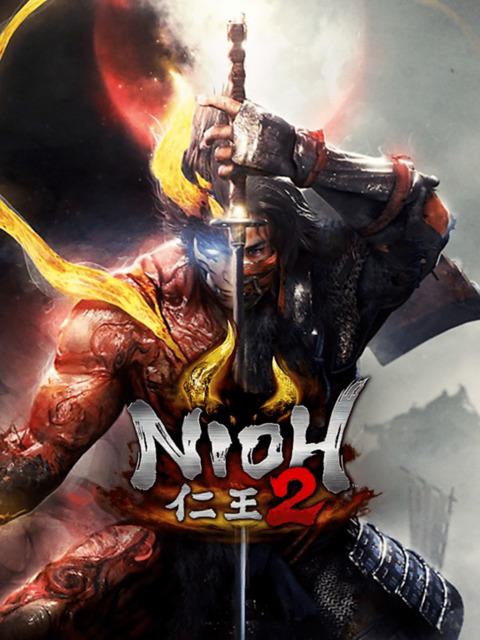
Log in to comment